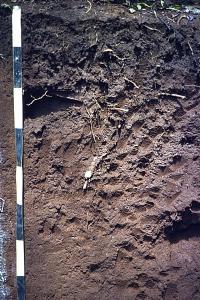Reference soil Kenya 16: Nitisol
Nitisols occur mainly in the tropics and subtropics, as well as in areas with a Mediterranean type of climate. They are associated with basic rocks (e.g. basalts) or hard limestone or dolomite deposits.
Characteristics
Soils having a nitic horizon (a horizon with pronounced nut-shaped soil structure and significant amount of active iron) within 100 cm from the soil surface, and gradual to diffuse horizon boundaries between the surface and the underlying horizons. They do not have a ferric, plinthic or vertic horizon within 100 cm from the soil surface.
Reference soil KE016: Nitisols
A porous, deep-rooting clayey soil in forestal upland, of volcanic origin (trachytes), with 40 % trees, 20 % shrubs, and 40 % herbs. Below 10 cm clay cutans appear increasing with depth; soft sesquioxidic accumulations in Bt2 horizon. In the Bt1 horizon there are some charcoal fragments; partly consolidated ash is observed at one side of the soil pit at 71 cm depth.
